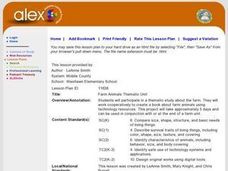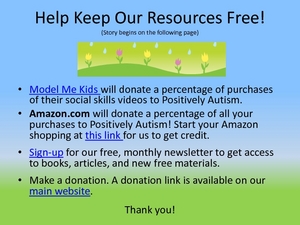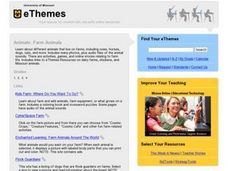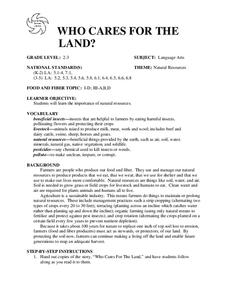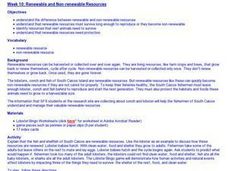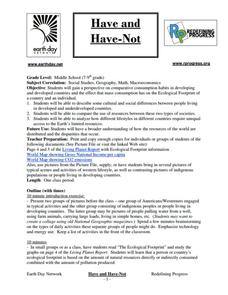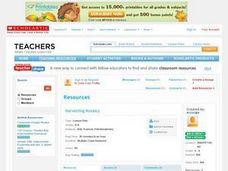Curated OER
Farm Animals Thematic Unit
Student study farm animals by watching a teacher made PowerPoint presentation and visiting a farm. They research a farm animal with teacher assistance. They design a book about the animals using available technology and orally present...
Curated OER
Travis the Train: Spring Time Animals
Tag along with Travis the Train as he encounters various baby animals that live on the farm. The spring time story introduces special-needs or autistic children to the types of plants and animals found on farms, each animal is identified...
Curated OER
Animals: Farm Animals
Learners examine the different types of animals that live on a farm. They participate in online games and activities to help them explore the different types of farm animals.
Curated OER
Farm Animals
First graders conduct research about farm animals and what it is like to live on a farm. They explore a variety of websites and complete an online WebQuest. They select a farm animal, and write a report about their animal's...
Curated OER
Artificial Selection
The second lesson in the series begins with a starter activity discussing wild versus domesticated animals. Then, scholars play a card game, with optional variations, to emphasize artificial selection. Next, they attend a field trip to a...
Curated OER
Old MacDonald Had a Farm
Students complete various activities to investigate farm animals. For this farm animals lesson, students sing the song 'Old MacDonald Had a Farm,' and listen to sounds farm animals make. Students color pictures for farm animals and...
Curated OER
Soil, Designing the Small Farm of the Future
Students examine the history of farming. In this environmental farming lesson, students explore the web and complete a variety of activities in order to understand the necessity of local, sustainable, and small farms for the future....
Curated OER
Animals and Environments
Students listen to stories and identify animals and their young. In this animals lesson, students view videos about farm animals and create illustrations to show how animal babies change over time. Students discuss...
Curated OER
WHO CARES FOR THE LAND?
Students explore the importance of natural resources. They are given copies of the story, "Who Cares For The Land," and students follow
along as the teacher reads it. Students identify the key points in the story. (Soil, water and air...
Baylor College
A Place to Be
Home sweet home. Humans, birds, beavers, ants, we all need a place place to rest and keep us safe. In the ninth lesson of this series, the importance of shelter is discussed as the teacher reads aloud the book Tillena Lou's Day in the...
Education Outside
Animal Homes in the Garden
First graders journey to the school garden to examine the habitats of garden animals. Using the provided graphic organizer, kids locate and sketch a critter and its habitat before returning it to its home.
Curated OER
Renewable and Non-renewable Resources
Students play Lobster Bingo on a provided worksheet. This game demonstrates how human activities and natral events affect lobsters by impacting their food, clean water, and shelter of the reef.
Curated OER
Travis The Train Visits the Farm in Spring
Travis the Train has made his way to a spring time farm and your special ed class gets to meet all his new friends! Each colorful page features an image of a baby animal and the sound they most commonly make. Print out this book or show...
Redefining Progress
Have and Have-Not
Is there a correlation between a country's wealth and the extent of its ecological footprint? What exactly constitutes an ecological footprint, and how does one country stack up against the rest? This is a unique lesson to incorporate...
Agriculture in the Classroom
"Steer" Toward STEM: Careers in Animal Agriculture
Think like an engineer and an agricultural scientist over the course of 12 lessons in a STEM based unit. Young scientists take on the roles of animal physiologists, animal geneticists, agricultural engineers, animal nutritionists,...
Curated OER
Plants, Animals and Our Environment
Students draw and label the basic needs of animals. They draw and label the basic needs of plants. Students understand the basic needs of plants and animals are not only the same, but are interrelated. They know that the environment...
Global Oneness Project
The Consciousness of Nature
Scholars voice their opinions about animal consciousness with an article that challenges common ideas about nature. After reading the article, learners engage in a thoughtful discussion before writing out their arguments...
Curated OER
Harvesting Mosaics
Students use pieces of farm pictures to investigate the elements of art. In this farm art lesson, students use pieces of pictures to create an original artwork. Students use the Internet to find images. Students create a...
Curated OER
Who's Who?
Students explore biology by identifying animals and their environments. In this animal characteristic lesson, students read assigned text about farm animals, how they are raised, and what they are used for in our society. Students view a...
Curated OER
Which Animal Lives Where?
Use this lesson in your classroom for a quick and easy way to review animal habitats. Young children use magazine clippings, pictures provided, or other resources to create a collage depicting an animal habitat. This is a great way to...
Curated OER
Amazing Animals
Students, in beginning and advanced beginning ESL levels, use English in an animal lesson.
Curated OER
Cows, Worms and Compost
Third graders explore agriculture by viewing a PowerPoint presentation in class. In this animal relationship instructional activity, 3rd graders identify the types of farm animals humans feed on and their dependency on such small insects...
Curated OER
Chicken
In this chicken coloring page worksheet, students study a line drawing of a large chicken. There are no directions; this appears to be a coloring page.
Curated OER
My Farm Web
Third graders explore agriculture by viewing video clips in class. In this farm animal activity, 3rd graders identify the animals mostly eaten that come from farms and the types of food they consume before they are eaten by us. Students...
